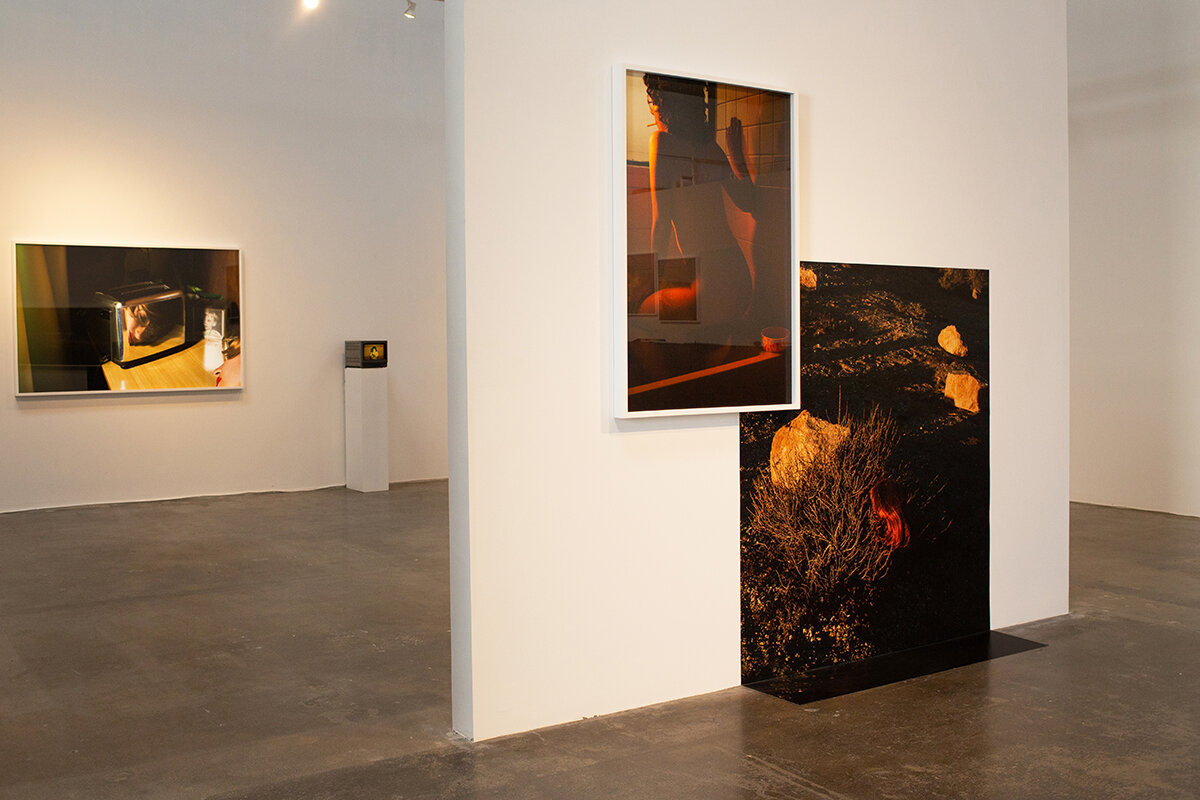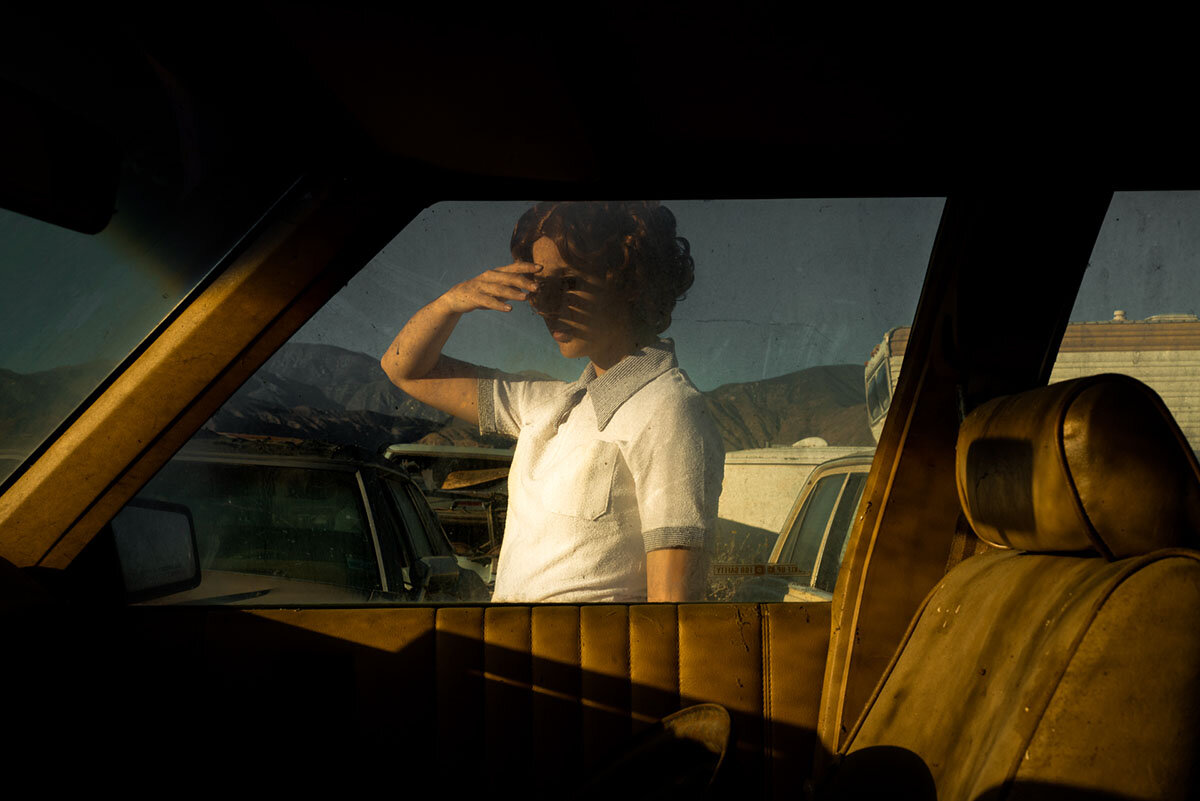For Edgar Allan Poe, there was nothing as “poetical” as the death of a beautiful woman. For the past eighty years, Los Angeles’ creative minds have taken this musing from the Baltimore-based poet and splashed it into the popular imagination through noir and detective films. The beautiful dead woman—or, depending on the example, the beautiful sad woman who is not yet dead—is a
hallmark of the (often misogynist)
genre and a staple in
Proceed to the Route,
Tania Franco Klein’s solo exhibition at
Rose Gallery through February 15, 2020, at Bergamot Station in Santa Monica, California.
 |
| The Waiting © Tania Franco Klein |
Klein’s photographs are sumptuously saturated images of the artist in various guises, acting out different roles in unknown, barely hinted-at stories in bathrooms, motel rooms, kitchens. None of the female subjects in these photographs seem happy, at the very least, while some of the images take the stylized, beautiful misery even further by hinting at (or depicting) their tragic deaths. Everything here is gorgeous ennui, cigarette smoke, and jewel-toned emptiness.
The works are hung at various heights around the gallery spaces, helping viewers identify with the subjects. Most notably,
Arrival and Departures, located near the entrance of the gallery, depicts a woman standing in a pair of shoes against a red-brown carpeted floor and is hung at the height of the viewer’s feet. The wall text for
Proceed to the Route references Cindy Sherman, and her influence is evident in the 2017 works
Apartment (Self-portrait), Red (Self-portrait), and
Dining Room (Self-portrait). While individually lovely, these photographs indulge in their own mystery and do not significantly push Sherman’s template further into uncharted territory.
 |
| Arrival and Departures © Tania Franco Klein |
|
|
In
Toaster (Self-portrait) (2016) the female subject is only visible in the reflection of her perfect shiny toaster, meaning that we, the viewer, can understand that she’s laid her head down on the kitchen counter for some unknown reason—hovering between being just outside the woman and occupying her point of view exactly. Franco Klein succeeds most in her push to have the viewer consistently negotiate the boundaries of their viewing of the figures as spectacle and their identifying with the figures as people.
 |
| Toaster (Self-portrait) (2016) © Tania Franco Klein |
Ophelia, Diptych (Self-portrait) (2018) is the most thought-provoking work in Proceed to the Route. The diptych depicts a female figure lying in a body of water in partial view: the photograph on the left shows the girl’s torso and thighs, with her arms lying limply by her sides, while the image on the right shows the waist-up—but with the arms notably raised, her hands breaking through the surface of the water.
It’s not simply one image arbitrarily divided into a diptych format, but arguably two discrete final moments in this mysterious woman’s life as she drowns smashed together for maximum impact. If viewed from left to right, it’s almost a reverse progression of events: in the right image her arms seem to still be struggling to keep her afloat, while the image on the left she has succumbed and struggles no more.
And yet her suffering and her inevitable death implied in the left image, gestures towards the noir eroticism of the beautiful dead woman while simultaneously criticizing it and implicating the viewer. It’s spellbinding, and the woman is beautiful; we look back and forth between the two images, titillated by the thrill of danger and tragedy, as if so entranced by the drama of it all that we didn’t bother to help her—all we did was watch and observe. We don’t want to dispel the aura of erotic suffering, so we allowed her to drown while simultaneously thinking about what a shame it is—what a sad thing, a beautiful girl dying like that. How “poetical.”
 |
| Ophelia, Diptych (Self-portrait) (2018) © Tania Franco Klein |
In
Proceed to the Route, Klein’s framed photographs are often clustered together against another image, usually of a natural setting or location, enlarged and reproduced directly onto the wall itself. Klein repeats this throughout the exhibition with varying degrees of success. In the best cases, the smaller images of her female subjects work in tandem with the larger image to create a loose narrative, or the photo directly attached to the wall allows for a deeper probing into the mind of the female subject in the smaller photograph.
 |
| Installation view |
Similarly, the rich, monumental
Car, Window (Self-portrait) (2018) is juxtaposed against the wallpaper installation
Borders (2017) for a powerful psychological effect. In
Car, Window, the female protagonist, as graceful and still as a
Piero della Francesca figure, is viewed through the windows of the front seats of a car, her hand lifted above her eyes to shade her face from liquid golden light. Borders, meanwhile, depicts a broken white fence in a similar warm light, punctuated by tumbleweeds at the base of a hill. We can imagine, then, that this landscape is what the woman in the other photograph is observing—a cinematic cut from an establishing shot to a point-of-view shot.
.jpg?format=1500w) |
| Car,Window (self portrait) © Tania Franco Klein |
For example, a series of three photographs in a black-and-white wallpaper installation depict a pale-haired woman viewed from behind standing in a field with an old-time airplane
(Plane Sequence, 2018), and two color photographs of female figures overlapping the black-and-white work’s edges. In one of the color photographs,
Plane (Self-portrait), a woman’s face is shown in extreme closeup, with only her mouth, chin, blond hair, and neck visible in what appears to be the same field-and-plane setting, while in the other photograph,
Proceed to the Route (2018), a woman stands in a red dress and scarf with one arm raised; the wind blows the scarf high enough to engulf and hide her face entirely.
 |
| Installation view |
While it’s perhaps a literal interpretation, this cluster of photographs unmistakably evokes the beautiful, sad figure of Marilyn Monroe. The tiny beauty mark near the woman’s mouth in
Plane (self-portrait), the inclusion of short blond hair in
Plane (Self-portrait) and its implication in the black-and-white
Plane Sequence, and the frustration and resignation in the body language of
Proceed to the Route work together to conjure up an impression of the famous blonde bombshell who wished people would see her as more than her image.





.jpg?format=1500w)

Comments
Post a Comment